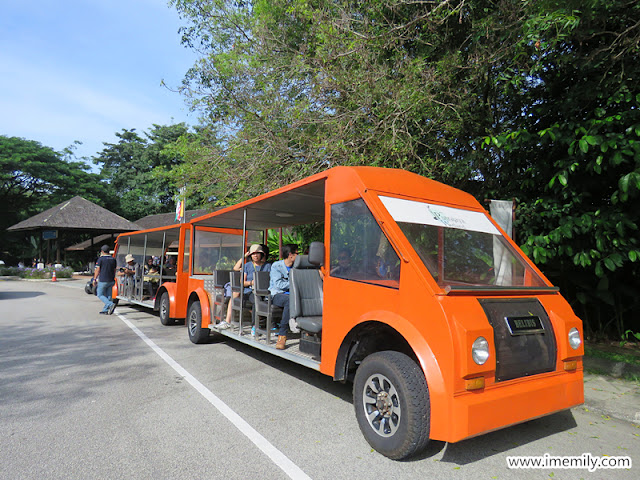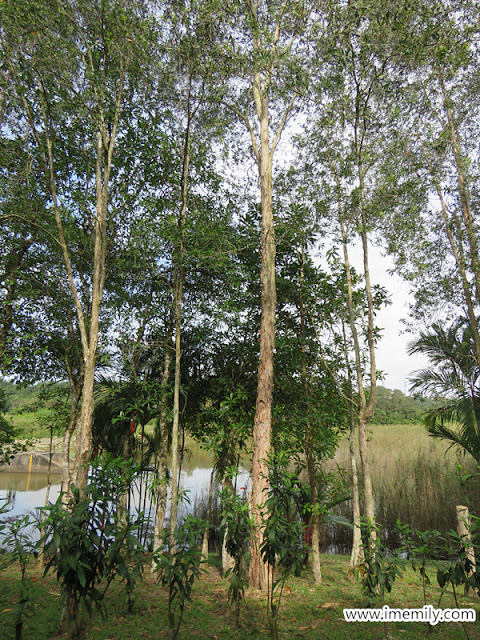Putrajaya Wetland Park is an important water catchment area that naturally controls siltation, and pollution and regulates the ecological system in the wetlands. The wetlands filter the water entering the lake as well as assist in flood mitigation.

The wetlands are divided into twenty four areas, called cells. These cells are filled with various species of marsh plants, including giant bullrush and common reed, and these cells act as a natural filter for water flowing from Sungai Chuau and Sungai Bisa before entering Putrajaya Lake.

A place you definitely must visit before starting your tour of the wetlands is the information centre in front of the parking area. You can choose to either navigate the wetlands by tram ride or bicycle. The tram, however, only operates during certain hours (9:30am, 11:30am in the morning, and 3pm, 4pm in the evening). You can rent bicycles from the information centre at a rate of RM15 per hour.

I rented a bike to cycle around in the park during my first visit in 2016.

So for my second visit, I took the tram instead so that I could listen to the tour guide’s explanation and take photos of the wetlands.


The park contains 32 rare fruit species, 32 forest tree species and 48 mixed varieties that produce medicines and perfumes. A total of 58, 685 trees and shrubs from 186 species were planted in this park. Collectively, these plants attract a variety of insects and small animals that play a crucial role in the ecosystem.

During my tram ride, the tram made a sudden turn into a narrow off-road trail between the ponds. The guide then showed us the plants that grew there that needed to be removed frequently by park staff to ensure that the water did not stagnate. The plants would later be used as fertiliser.

When the guide asked us what some fruits were used for, I answered without much hesitation, “Jeruk (Pickles)”. We were all quite shocked when the guide told us that the fruit he was showing us was actually POISONOUS. Known as the pong-pong or suicide fruit, it is well known in India as a common means of suicide in the sub-continent. It causes heart failure which leads to death. A fatal dose of the poison is contained in a single kernel and will lead to death within 1-2 days. So why are the fruits planted in the wetlands? It acts as a biological pest control agent by reducing the population of snakes as the park was formerly a forest and an oil palm plantation.

Another tree species he showed us was the tall white trees by the lakeside. He said that the bark could be extracted as medicated oil, such as minyak cap kapak.

We also spotted numerous birds at Swan Lake. Among the birds, we recognised a white pelican. They are characterised by a long beak and a large throat pouch used for catching prey and draining water from the scooped-up contents before swallowing.

A pair of Egyptian geese (Alopochen aegyptiaca) was also spotted. These geese were domesticated by ancient Egyptians who considered them as sacred. On the other hand, Romans and Greeks kept them as domestic poultry.

We were quite lucky as we arrived during feeding time. To our surprise, the birds walked and swam into the water just before we spotted the feeders. Certainly, this means that the birds know roughly their feeding time. The feeder came by boat and filled up the feeding areas in the water with a box of fish.

A flock of painted storks flew to the feeding place and ate as much as they could.

One landmark of the park is the Look-out Tower which stands 18 metres high, designed for visitors to enjoy panoramic views of the wetlands and the Putrajaya skyline. Among the plants, you can find there are tembusu (Fragraea fragran), mahang merah (Macaranga sp.) and wild mangosteen (Garcinia subelliptica).
Putrajaya Wetlands Park is undoubtedly a great place to reconnect with nature together with your family and friends. Don’t wait, there’s a whole ecosystem of diverse flora and fauna for you to explore!
Operating hours:
Park: 7am-7pm
Park services: 9-5pm (weekday); weekend&public holidays: 9-5.30pm
Nature Interpretive Centre: 9-5pm (closed on Monday)
Entrance fee: No

Never knew there is a sucide fruit
ReplyDeletehttp://www.amysfashionblog.com/blog-home
yup I also surprised with it. Careful not to pluck any fruits to eat before asking :)
DeleteNice trip!
ReplyDeletethanks dear :)
DeleteI came here for a walkathon once many years ago but have yet to explore its beauty in full. Seeing your post makes me feel like going there.
ReplyDeleteHehehe nice place for couple date :D
Delete